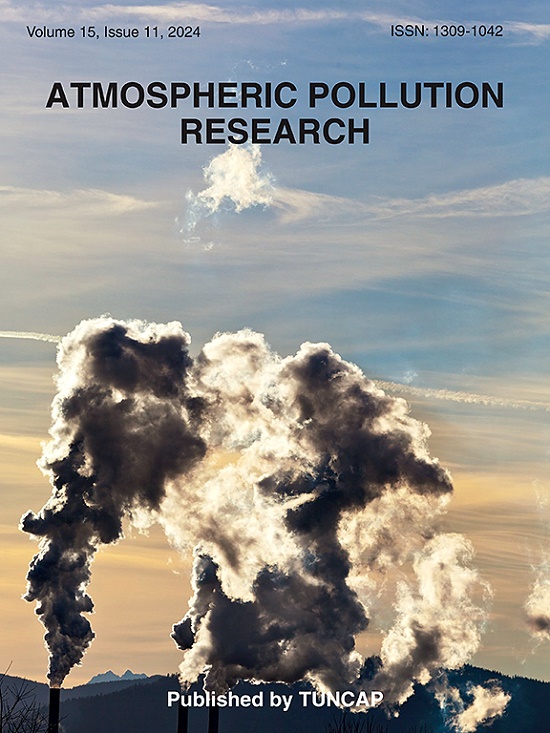Estimating hourly surface PM2.5 concentrations with full spatiotemporal coverage in China using Himawari-8/9 AOD and a two-stage model
IF 3.9
3区 环境科学与生态学
Q2 ENVIRONMENTAL SCIENCES
引用次数: 0
Abstract
PM2.5 (fine particulate matter with an aerodynamic diameter of less than ) is a significant air pollutant, posing serious risks to both the atmospheric environment and human health. Satellite remote sensing Aerosol Optical Depth (AOD) data are often used to estimate surface PM2.5 concentrations. However, satellite-derived AOD data are often affected by large-scale data gaps due to cloud contamination and high surface albedo, leading to discontinuities and incompleteness in surface PM2.5 estimations based on AOD. PM2.5 is influenced by natural and human activities, both of which show strong diurnal variations. Many previous studies have used AOD data from sun-synchronous orbiting satellites, whose coarser temporal resolution makes it difficult to capture these diurnal PM2.5 variations. In this study, AOD products from the new generation of geostationary meteorological satellites, Himawari-8/9, are employed to estimate spatiotemporally continuous hourly seamless PM2.5 grid data using a two-stage Random Forest (RF) model. This model integrates meteorological, surface, and demographic-economic factors. In the first stage, the RF model was used to fill the gaps in the satellite AOD data, achieving a good fit (), with a root mean square error (RMSE) and mean absolute error (MAE) of 0.05 and 0.03, respectively. In the second stage, the model estimates surface PM2.5 grid data (5 km 5 km) at hourly intervals during the daytime, based on the gap-filled AOD data, actual PM2.5 measurements from ground stations, and auxiliary data. The final hourly PM2.5 estimates were well-fitted to the ground station measurements (), with RMSE and MAE values of 7.14 and /m, respectively. This study provides a valuable approach for estimating complete, hourly-level spatial and temporal distributions of PM2.5 from incomplete satellite remote sensing AOD data, which is crucial for air quality management and assessing short-term exposure risks.
利用Himawari-8/9 AOD和两阶段模型估算中国全时空覆盖的逐时地表PM2.5浓度
PM2.5(空气动力学直径小于2.5μm的细颗粒物)是一种重要的大气污染物,对大气环境和人体健康构成严重威胁。卫星遥感气溶胶光学深度(AOD)数据常用于估算地表PM2.5浓度。然而,由于云层污染和高地表反照率,卫星获取的AOD数据经常受到大范围数据缺口的影响,导致基于AOD估算的地表PM2.5不连续性和不完整性。PM2.5受自然活动和人类活动的影响,均表现出较强的日变化。以前的许多研究都使用了来自太阳同步轨道卫星的AOD数据,这些卫星的时间分辨率较粗,因此很难捕捉到PM2.5的日变化。本研究利用新一代地球同步气象卫星Himawari-8/9的AOD产品,采用两阶段随机森林(Random Forest, RF)模型估算PM2.5时空连续逐时无缝网格数据。这个模型综合了气象、地表和人口经济因素。在第一阶段,利用RF模型填补卫星AOD数据的空白,获得了良好的拟合(R2=0.95),均方根误差(RMSE)和平均绝对误差(MAE)分别为0.05和0.03。第二阶段,基于补空AOD数据、地面站PM2.5实测数据和辅助数据,以每小时为间隔估算白天地面PM2.5网格数据(5 km × 5 km)。最终每小时PM2.5估计值与地面站测量值拟合良好(R2=0.92), RMSE和MAE值分别为7.14和4.90μg/m3。本研究为利用不完整的卫星遥感AOD数据估算PM2.5的完整小时时空分布提供了一种有价值的方法,这对空气质量管理和评估短期暴露风险至关重要。
本文章由计算机程序翻译,如有差异,请以英文原文为准。
求助全文
约1分钟内获得全文
求助全文
来源期刊

Atmospheric Pollution Research
ENVIRONMENTAL SCIENCES-
CiteScore
8.30
自引率
6.70%
发文量
256
审稿时长
36 days
期刊介绍:
Atmospheric Pollution Research (APR) is an international journal designed for the publication of articles on air pollution. Papers should present novel experimental results, theory and modeling of air pollution on local, regional, or global scales. Areas covered are research on inorganic, organic, and persistent organic air pollutants, air quality monitoring, air quality management, atmospheric dispersion and transport, air-surface (soil, water, and vegetation) exchange of pollutants, dry and wet deposition, indoor air quality, exposure assessment, health effects, satellite measurements, natural emissions, atmospheric chemistry, greenhouse gases, and effects on climate change.
 求助内容:
求助内容: 应助结果提醒方式:
应助结果提醒方式:


